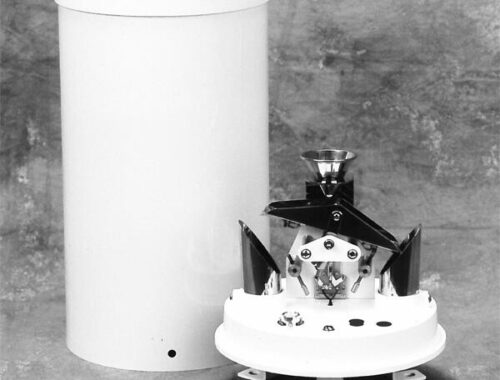The Climber Running the World’s Largest Telescope
Sean Dougherty made a name for himself as a talented climber in the Canadian Rockies. Now he’s starting a new adventure in one of the most extreme environments on earth.
Name: Sean Dougherty
Job: Director of the Atacama Large Millimeter/submillimeter Array Observatory
Home Base: Santiago, Chile
Age: 56
Education: Undergraduate degree in math and physics from Nottingham University; master’s degree in geophysics and PhD in astrophysics from the University of Calgary
Running the world’s largest telescope was not part of Sean Dougherty’s career plan. The Englishman jokes that mountains, not the sky, lured him to his first job in astronomy: “The Canadian Rockies are my soul place, and the Okanagan has good climbing weather ten months a year,” he says. Dougherty had been running the Dominion Radio Astrophysical Observatory in Kaleden, British Columbia, for ten years when he applied to become the director of the Atacama Large Millimeter/submillimeter Array (ALMA) Observatory in Chile. “I threw my hat in the ring not thinking I actually had a shot at the job,” he says.
Climbing had been Dougherty’s priority for most of his life. While earning his PhD in astrophysics from the University of Calgary, Dougherty wrote Selected Alpine Climbs in the Canadian Rockies. He was on a number of first and second ascents in Canada, including the second ascent of the Wild Thing—one of the few climbs in the world graded V 5.9 A2 at the time—with Joe Josephson and Grant Statham in 1992. Dougherty lost a few climbing friends to the mountains, but when a close climbing buddy committed suicide four years ago, “I decided I needed to take a break and think more about my responsibility as a father,” he says. “I went from climbing nearly every day of the week, even bringing my kids bouldering with me, to climbing a handful of times a year.”
His five-year stint as director of the ALMA Observatory, which officially began in April, is a new kind of adventure. “I was awestruck the first time I saw the beauty and vastness of the Atacama,” Dougherty says. “It’s the closest you can get to being on Mars on Earth.” We asked him about his day-to-day work of looking up at the sky from a new hemisphere.
On His Job Description: “In a nutshell, I’m in charge of the most complicated telescope technology in the world. The goal of ALMA is to study star formation, molecular clouds, and the early universe. The telescope sits at 17,000 feet in the Atacama and is supported by three main agencies: the European Southern Observatory, the National Science Foundation of the United States, and the National Institutes of Natural Sciences of Japan. I am responsible for managing the day-to-day operations on behalf of these three organizations and ensuring that the telescope delivers high-quality data to the user community.”
On His Workspace: “The observatory is on the Chajnantor Plateau in the Chilean Andes at 17,000 feet. There are usually about 100 staff on site at any given time—mostly engineers who keep the telescope and facility up and running. We live at the operations support facility down the road at 10,000 feet. I do okay personally at altitude, but staff are given oxygen. I have an office in Santiago, where 70 of the 274 staff are located—mostly managers and administrative support. I also travel to our support agencies around the world.”
On His Hours: “Twelve-hour days are not unusual. When you’re in my position, you’re never really off; the phone is never too far away.”
On the Most Fulfilling Part of His Job: “Working in great collaboration has been thrilling for me, especially when you get to play a role in successful projects. I worked with the team that built the supercomputer [for the Karl G. Jansky Very Large Array astronomy observatory] in New Mexico, and it was a fantastic feeling when we finished that project. I’m a big believer in teams.”
On How Someone Else Can Break into His Profession: “If you want to be a director of an observatory or work at a large science facility, you need to understand research. A master’s degree is essential, and postgrad helps. Working in a research job two to six years to gain experience in research and then applying for jobs in academia is the typical roadmap. If you want to work as a technician or a welder—someone who keeps the telescope working—you don’t need a degree, just hands-on technical experience.”
On His Favorite Daily Ritual: “I took up the harmonica when my daughter started learning the violin nine years ago. I practice for an hour every morning. I usually travel with four or five, but I have around 20.”
On Breakfast: “I’m a coffee snob. I have the Rocky Coffee Grinder and the Rancilio Silvia Espresso Machine. The coffee experience they produce is worth every penny. I usually eat granola or whole-wheat toast with marmalade, since I’m English.”
On the Habit He Would Most Like to Break: “Chewing my fingernails. It’s a disgusting habit and usually happens when I’m driving. I’ve managed to do well the past month or two and have had to clip them.”
On Achieving Work-Life Balance: “You have to make life a priority or work can easily consume you. I’ve only achieved balance in the past eight years or so. I used to always take work home. Now I set boundaries. When I’m home, I’m with family and I’m 100 percent present. Climbers are probably some of the most selfish people. It’s just the nature of what they do. When I climbed, climbing was my life. Having a family was a good way for me to readjust to what is important.”
On How He Uses His Free Time: “I like road and mountain biking. The scenery in Chile is stunning, and the roads are surprisingly quiet. I was starting to feel jealous seeing friends from the Okanagan posting face shots back home this ski season, but I’ve taken my mountain bike to Farellones ski hill, and it’s been great to explore the little villages and trails. I also have to keep on top of my research career. People are incessantly coming up with new ideas, and different fields are moving along quickly.”
On What He’s Reading: “The Art of Freedom by Bernadette McDonald is the story of the incredible Polish climber Voytek Kurtyka.”
On Wardrobe Essentials: “I love all the technical wear I have from Rab, a clothing line started by UK climber Rab Carrington.”
On His Favorite Piece of Technology: “My Samsung Galaxy S7 cellphone is like a little portable computer.”
On the Career He Would Choose If He Couldn’t Do His Current Job: “I’ve been playing in a blues band for the past ten years and think it would be pretty cool to play a stadium for thousands of people. Then again, I see posts of heli-ski guides on Facebook and think, ‘Man, his office doesn’t look too shabby.’ You always think the grass is greener, but then I remind myself that I have a dream job where I get to travel and every day is different.”
You May Also Like

AI in Fashion: Revolutionizing Design, Shopping, and Sustainability for a Smarter Future
March 1, 2025
10 Practical Applications of Rain Gauges in Everyday Life
March 20, 2025